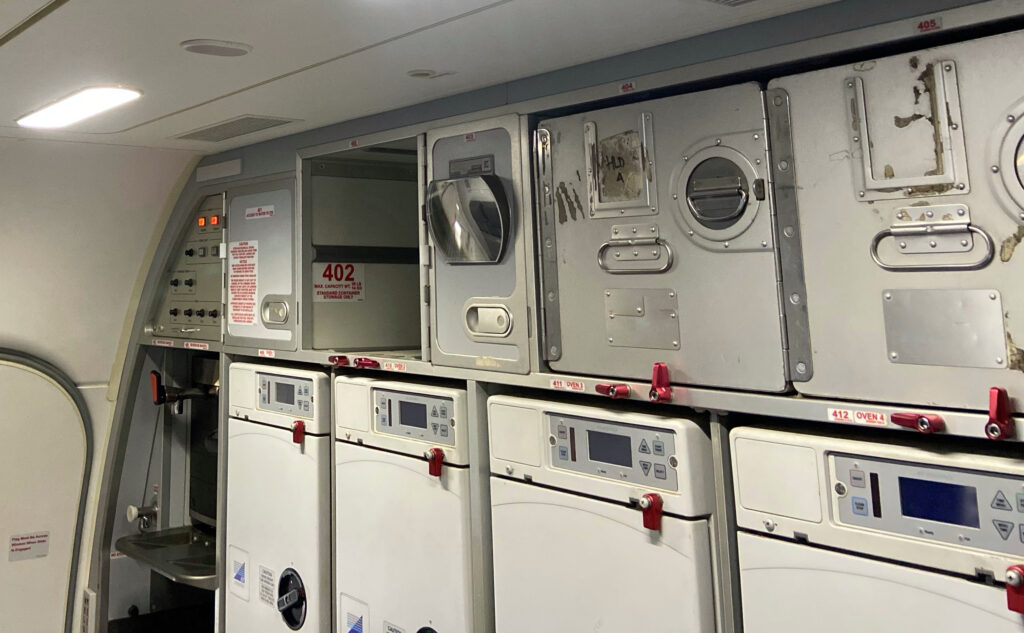Invoicing Models for On-Board Sales Based on Supply Chain Ownership

Introduction
In the complex ecosystem of in-flight retail, the simple act of buying a snack, a perfume, or a gift during a flight is the visible tip of a sophisticated supply chain iceberg. Behind every product sold on board, there are multiple actors involved — manufacturers, distributors, airlines, and On-board retailers — each playing a distinct role in producing, moving, and ultimately selling the product to the passenger.
Ownership of these products changes hands several times before it ever reaches the aircraft cabin. Each stage of this journey brings with it contractual obligations, cost structures, and revenue-sharing models that directly impact how the final price is set and how the profits are distributed.
For airlines, in-flight sales have evolved from a minor convenience to a significant revenue stream, especially as margins on ticket sales shrink. However, the complexity of supply chain ownership models creates challenges when it comes to invoicing and revenue recognition. Who owns the product at each step? When does ownership transfer? How are taxes and fees applied based on jurisdiction and location of sale? These are critical questions that shape not only the operational but also the financial planning of On-board sales.
Understanding the Key Logistics Spaces in On-board Sales
Managing On-board sales is not just about offering the right products to passengers — it’s about understanding and controlling where those products are at every stage of the journey. The logistics flow for in-flight retail spans multiple physical and operational spaces, each with its own processes, risks, and cost implications. Broadly, we can break down this flow into four key spaces:
1. Wholesale Market:
The product journey begins in the warehouses of manufacturers or distributors. At this stage, products are considered part of the general wholesale market inventory. The airline or On-board retailer may not yet have financial exposure or ownership of the stock. Logistically, this space offers flexibility. Products can be sourced from multiple suppliers, consolidated, and negotiated based on market prices, availability, and demand forecasts.
2. Packing Warehouse (Catering Location):
Once selected for On-board sales, products move to the packing warehouse, often referred to as the catering location. This is a critical transition point in the supply chain. Here, individual items are bundled according to the service plan — grouped by flight, destination, or even cabin class. Depending on the ownership model, this could also be the point where the product changes hands, triggering invoicing or stock valuation. The packing location must handle not just logistics, but also quality control, expiry checks, and preparation for customs clearance if international routes are involved.
3. Loading Product into Service Trolleys
At this stage, the products are carefully loaded into service trolleys or dedicated containers. For some contractual models, ownership is transferred at the very moment the products leave the packing warehouse and are loaded into these mobile storage units. This transfer signifies the start of the airline’s or On-board retailer’s financial responsibility for the stock, making accurate stock tracking is essential to avoid discrepancies and ensure accountability.
4. Service Trolleys Handed to Cabin Crew
In other models, the final transfer of ownership occurs later — when the service trolleys are handed over to the cabin crew. This moment represents the final pre-sale stage, where products are ready for in-flight presentation and sale. The timing of this transfer can have significant implications for inventory control, invoicing processes, and the calculation of revenue, particularly if unsold stock needs to be managed post-flight.
By clearly delineating these stages and pinpointing the moments of ownership change, On-board sales and logistics managers can better navigate the complexities of invoicing models. This structured approach not only enhances operational efficiency but also provides greater transparency and accuracy in financial management.

Defining the Key Actors in On-board Sales Invoicing
Before delving into the roles of the key actors, it’s important to note that products remain the property of the manufacturer or distributor until they are received at the warehouse. This critical juncture is managed by most modern warehouse management systems (WMS) and enterprise resource planning (ERP) systems, which ensure accurate tracking and recording of product movements. These systems automatically verify when products are received, effectively marking the end of the manufacturer’s or distributor’s direct responsibility and setting the stage for subsequent inventory management and invoicing processes.
To effectively manage and optimize invoicing processes in On-board sales, it is essential to clearly define the roles of the two primary actors involved:
In-Warehouse Owner
The In-Warehouse Owner represents the entity—typically the manufacturer or distributor—that holds responsibility for the product while it remains in the initial stages of the supply chain. This ownership extends from the point of production or initial distribution through to the packing warehouse (or catering location). In this phase, the In-Warehouse Owner is accountable for sourcing, inventory management, quality control, and preparing products for onward transit. Their invoicing model typically reflects wholesale transactions, setting the foundation for subsequent cost and revenue allocations once the product moves further down the supply chain.
Trolley Content Owner
The Trolley Content Owner takes over when products transition into the mobile stage of the supply chain. This actor becomes responsible for the product once it is loaded into service trolleys or dedicated containers, or alternatively, when these trolleys are handed to the cabin crew, based on the contractual model in place. The Trolley Content Owner’s role is central during the final stages of the journey, ensuring that the inventory on board is accurately tracked, managed, and ultimately converted into revenue through in-flight sales. Their invoicing and revenue recognition processes differ, reflecting the transition from warehouse inventory to sellable stock.
Products may be loaded on consignment, a model where ownership remains with the caterer or retailer even after the goods are transferred to another party, typically the seller, such as an airline or On-board retail partner.” Under this arrangement, the consignor retains title and bears the risks associated with the inventory until the product is sold. The consignee manages and sells the product on behalf of the original owner, allowing for greater flexibility in inventory management and reducing financial risk for the seller. This approach is particularly advantageous in On-board sales, where fluctuating demand and limited storage space require a careful balance between inventory risks and potential rewards.
How On Board Logistics Systems may Invoice Products
Robust On-board sales logistics systems must be capable of accounting for diverse ownership models throughout the product lifecycle. Modern systems need to seamlessly integrate data from warehouse management, enterprise resource planning, and inventory control to accurately track each transition—from the initial in-warehouse stage to the moment products are loaded into trolleys or handed over to cabin crew, and even when managed on consignment. This adaptability ensures that ownership changes are clearly recorded and reconciled, facilitating precise invoicing, timely revenue recognition, and enhanced overall operational efficiency.
Invoicing for On-board sales can be streamlined into two models. The first model is based on the quantities effectively loaded into the trolleys. Under this approach, invoicing is triggered once products have been confirmed as loaded into their designated storage units, establishing a clear, quantifiable benchmark for revenue recognition and inventory accountability. The second model focuses on trolley stock variation, tracking the changes in inventory levels from the point of loading to post-flight counts. This dynamic approach accounts for discrepancies due to sales, losses, or other operational variances during the flight, thereby enabling more responsive financial adjustments and enhanced inventory management.
Invoicing Based on Loaded Quantities
In the loaded-quantities invoicing model, packers are central to ensuring accuracy and accountability. They are responsible for counting and loading items according to a predefined load plan. These load plans can be static, crafted by human experts for different routes, aircraft types, cabin configurations, and other factors, and updated seasonally to account for predictable trends and fluctuations, or they can be dynamically generated. With the integration of artificial intelligence and predictive models like random forests, dynamic load plans harness historical data and real-time analytics to optimize the loading process. This dual approach not only streamlines the invoicing process by tying it directly to the physical inventory loaded into trolleys but also enhances operational flexibility and precision.
In the dynamic loading model, On-board sales logistics are tailored to the specific demands of each flight sequence, taking into account variables such as varying origins and destinations, the specific aircraft assigned, and the anticipated number of passengers on each leg. This approach leverages advanced predictive analytics and artificial intelligence to generate load plans that are finely tuned to the unique characteristics of each flight. By doing so, airlines can optimize inventory levels, ensuring that the right products are available to meet passenger demand without overloading the aircraft, thereby enhancing both customer satisfaction and operational efficiency.
Invoicing Based in by Stock Variation
Invoicing based on stock variation operates differently, requiring a detailed inventory reconciliation at the end of the flight or flight string. This model relies on performing a closing inventory, where the remaining quantities of each product in the trolleys are counted and recorded. Additionally, it is essential to register any products that were damaged, expired, or otherwise deemed unsellable during the service. By comparing the closing inventory against the initial loaded quantities, the system calculates the exact number of items sold. This approach allows for more flexible, real-demand-driven invoicing but also requires strict controls and robust systems to ensure accuracy in inventory reporting and damage registration.
Furthermore, operational errors or misrouting can result in products being assigned to routes where they cannot legally be sold. Certain items may be restricted due to customs regulations, import laws, or other legal constraints specific to a country or region. In these cases, On-board sales systems must be capable of identifying and flagging such situations in real-time or during pre-flight preparation. Products subject to these restrictions must be marked as detained or non-sellable for that specific route, ensuring they are excluded from sales reporting and inventory calculations. Additionally, the system should generate proper records for customs and legal compliance, minimizing financial exposure and protecting the airline or retailer from regulatory penalties.
Conclusion
Managing invoicing models for On-board sales is a complex task that goes far beyond simply counting what gets sold in the air. With multiple actors involved—manufacturers, distributors, caterers, airlines, and On-board retailers—ownership of the products can shift at various stages of the supply chain. Whether ownership transfers when products are loaded into trolleys or only when handed to the cabin crew, these moments define how invoicing is structured and how risks are shared.
Adding to this complexity is the need to handle consignment models, where products are sold on behalf of another party, and the system must always be aware of who truly owns each item. On-board sales logistics systems must therefore be designed to manage these varied ownership scenarios, accurately tracking stock movements and supporting two distinct invoicing approaches: one based on loaded quantities and another on stock variation.
Dynamic loading models, driven by AI and predictive algorithms, further optimize what gets loaded by factoring in aircraft, route, and expected passenger numbers. Meanwhile, robust inventory and compliance controls are essential to handle damaged goods, unsold stock, and products mistakenly loaded onto restricted routes where sales are not allowed.
In the end, success in On-board sales logistics and invoicing lies in designing systems capable of embracing this complexity—providing transparency, ensuring legal compliance, and optimizing revenue opportunities at every stage of the journey.

I set out to build a realistic simulation of an airline, something that could mimic the operational, logistics and business aspects as well. That meant not only creating some random routes and inventory. I wanted to simulate airline strategy: which cities should be connected? should an airline select? What would the operating costs be—from airport […]

Earlier this month, Neurologistica had the privilege of participating in the World Travel Catering & Onboard Services Expo (WTCE) 2025 in Hamburg. As a premier event in the travel catering and onboard services industry, WTCE provided an excellent platform for us to present our latest innovations and connect with industry leaders. Introducing NL-TRACK: Revolutionizing Container […]

We are pleased to announce that Neurologistica has officially joined the Microsoft for Startups Founders Hub program. This strategic collaboration represents a significant milestone in our ongoing commitment to delivering innovative, technology-driven solutions in the logistics sector. About the Partnership By becoming a member of the Microsoft for Startups Founders Hub, Neurologistica will have access […]

The airline industry has long been characterized by razor-thin profit margins, volatile fuel prices, and ever-shifting consumer demand. In this high-stakes environment, ancillary revenue has evolved from a supplementary income source to a crucial pillar of airline financial sustainability. Airlines that fail to capitalize on diverse ancillary revenue streams risk falling behind in an increasingly […]

Introduction In the complex ecosystem of in-flight retail, the simple act of buying a snack, a perfume, or a gift during a flight is the visible tip of a sophisticated supply chain iceberg. Behind every product sold on board, there are multiple actors involved — manufacturers, distributors, airlines, and On-board retailers — each playing a […]

In an industry defined by rapid changes and fierce competition, airlines are constantly looking for ways to stay profitable. A recent paper by José Jaume, Gustavo Alonso, and Arturo Benito from the Universidad Politécnica de Madrid offers fresh insights into how airlines can manage their businesses more effectively. The paper, titled “A Model for Managing […]

Neurologistica ÖU was officially founded on Wednesday, February 26, 2025. The company is actively developing the Neurologistica system and the NL Track application for advanced container tracking. The launch of these solutions is planned for mid-2025, aiming to enhance logistics efficiency with innovative technology. More updates to follow as development progresses.

